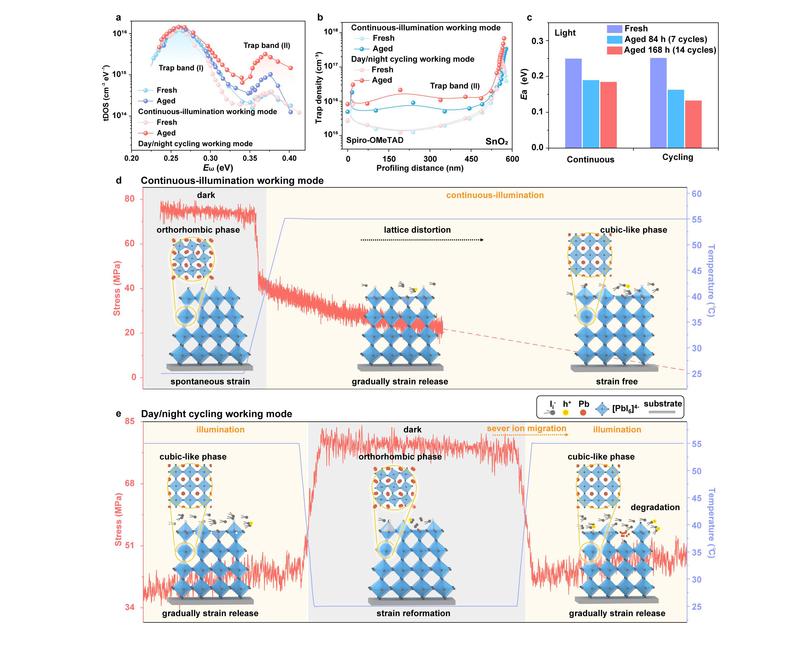Strain regulation retards natural operation decay of perovskite solar cells
Yunxiu Shen1†,Tiankai Zhang2†, Guiying Xu1†, Julian A. Steele3, Xiankai Chen4, Weijie Chen1, Guanhaojie Zheng5, Jiajia Li6, Boyu Guo7, Heyi Yang1, Yeyong Wu1, Xia Lin6, Thamraa Alshahrani8, Wanjian Yin9, Jian Zhu6, Feng Wang2, Aram Amassian7, Xingyu Gao5, Xiaohong Zhang4,10(张晓宏)*, Feng Gao2(高峰)*, Yaowen Li1,6,10(李耀文)* & Yongfang Li1,10,11
1Laboratory of Advanced Optoelectronic Materials, Suzhou Key Laboratory of Novel Semiconductor-optoelectronics Materials and Devices, College of Chemistry, Chemical Engineering and Materials Science, Soochow University, Suzhou 215123, China
2Department of Physics, Chemistry and Biology (IFM), Linköping University, Linköping, 58183, Sweden
3Australian Institute for Bioengineering and Nanotechnology and School of Mathematics and 13
14 Physics, The University of Queensland, Brisbane, QLD 4072, Australia.
4Institute of Functional Nano & Soft Materials (FUNSOM), Soochow University, Suzhou, Jiangsu 215123, P. R. China
5Shanghai Synchrotron Radiation Facility (SSRF), Zhangjiang Lab, Shanghai Advanced 17
18 Research Institute, Chinese Academy of Sciences, Shanghai 201204, China
6 State and Local Joint Engineering Laboratory for Novel Functional Polymeric Materials, Jiangsu Key Laboratory of Advanced Functional Polymer Design and Application, College of Chemistry, Chemical Engineering and Materials Science, Soochow University, Suzhou 215123, China
7Department of Materials Science and Engineering and Organic and Carbon Electronics, Laboratories (ORaCEL), North Carolina State University, Raleigh, NC 27695, USA
8Department of Physics, College of Science, Princess Nourah bint Abdulrahman University, 25
26 Riyadh 11671, Saudi Arabia
9College of Energy, Soochow Institute for Energy and Materials InnovationS (SIEMIS), Soochow University, Suzhou 215006, China
10Jiangsu Key Laboratory of Advanced Negative Carbon Technologies, Soochow University, Suzhou 215123, China
11Beijing National Laboratory for Molecular Sciences; CAS Key Laboratory of Organic Solids, Institute of Chemistry, Chinese Academy of Sciences, Beijing 100190, China
Nature, 2024,
Abstract: Perovskite solar cells (pero-SCs) have undergone a rapid development in the last decade. However, there is still a lack of systematic studies to investigate whether the empirical rules of working lifetime assessment used in silicon solar cells can be applied to pero-SCs. It is commonly believed that pero-SCs show enhanced stability under day/night cycling due to the reported self-healing effect in the dark.1,2 While we discovered that the degradation of highly efficient FAPbI3 pero-SCs is in fact much faster under natural day/night cycling mode, questioning the widely accepted approach to estimate the operational lifetime of pero-SCs based on continuous mode testing. We reveal the key factor to be the lattice strain caused by thermal expansion/shrinking of the perovskite during the operation, an effect that gradually relaxes under the continuous-illumination mode but cycles synchronously under the cycling mode.3,4 The periodic lattice strain under the cycling mode results in deep trap accumulation and chemical degradation during operation, decreasing the ion migration potential and hence the device lifetime.5 We introduce phenylselenenyl chloride (Ph-Se-Cl) to regulate the perovskite lattice strain during day/night cycling, which achieved the certified efficiency of 26.3% and a 10-time improved T80 lifetime under the cycling mode after the modification.

链接://www.nature.com/articles/s41586-024-08161-x